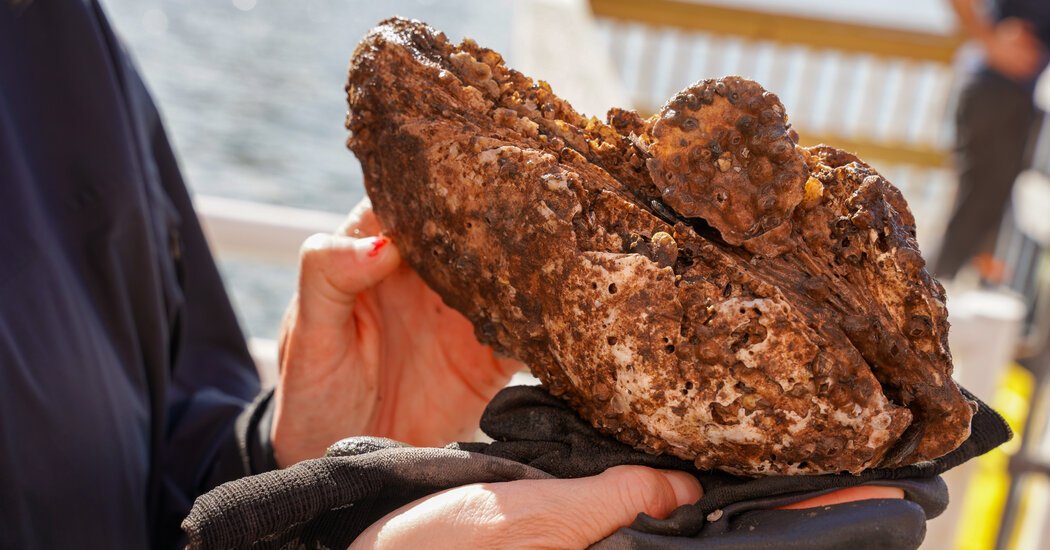11 Million New Oysters in New York Harbor (but None for You to Eat) – The New York Times
Advertisement
Supported by
The oysters, which act as nonstop water filters, were added to the Hudson River as part of an ongoing project to rehabilitate the polluted waterways around the city.
Send any friend a story
As a subscriber, you have 10 gift articles to give each month. Anyone can read what you share.
By Karen Zraick
The restoration of New York Harbor has reached a new milestone as 2021 draws to a close: 11.2 million juvenile oysters have been added in the past six months to a section of the Hudson River off the coast of Lower Manhattan, where they are helping to filter the water and creating habitats for other marine life.
The bivalves will not be headed to a serving platter: The waters are still too polluted to eat from freely, after absorbing centuries’ worth of trash, sewage and industrial waste. But the water quality in the area is steadily improving, and oysters — which were once so prevalent in the waters that they served as a staple in New Yorkers’ diets — are playing a key role in the shift.
The city was once one of the world’s great oyster capitals, exporting millions of them across the country and around the globe. They were sold from street stands, saloons and barges. New Yorkers of all social classes could enjoy them, whether raw, roasted, pickled, fried, or in chowders, sauces and stews.
In his book “The Big Oyster: History on the Half Shell,” the author Mark Kurlansky writes that the history of New York oysters is a history of the city itself. Years of over-harvesting and environmental degradation left the waters so fouled that oysters could not even survive there for a time. Now, in addition to the ones being introduced, wild ones are being found on the bottoms of piers off the West Side of Manhattan and in the Bronx.
It may be another 100 years before anyone can safely eat an oyster from the waters, said Carrie Roble, vice president for estuary and education at the Hudson River Park Trust’s River Project, a marine biology monitoring station on Pier 40, near West Houston Street.
But the oysters are a symbol of resilience, and a rare hopeful sign amid ominous news about New York waterways in the age of rapid climate change.
If they grow big enough, the oyster reefs can even play a role in dissipating wave energy, helping to protect the city’s shorelines from storm surges and flooding in extreme weather.
“They’re habitat-builders,” Ms. Roble said.
The newly deployed oysters are attached to more than 200 subtidal habitats, including metal orbs, cages and mesh wraps, in the water between Piers 26 and 34, off TriBeCa.
It’s the first large-scale habitat restoration within the Hudson River Park’s estuarine sanctuary, an area where fresh water from the river and saltwater from the Atlantic Ocean mix and create a nutrient-rich ecosystem for more than 85 species of fish.
Ms. Roble noted that the estuary is a crucial incubator for regional waterways, and that many types of fish migrate through the area or spawn there. Striped bass caught in Connecticut or New Jersey likely spent time in the Hudson when they were young.
And more vibrant marine life leads to exponential growth. For example, big populations of menhaden, a small silver fish, attract humpback whales that feed on them.
The $1.5 million project was designed by the Hudson River Park Trust, the New York State Department of Environmental Conservation and the engineering firm Moffatt and Nichol, using state funding.
The “seeded” oysters came from the Billion Oyster Project, a nonprofit with a mission to make its name a reality in New York Harbor by 2035. The group says it has already restored 75 million oysters to the area since its founding in 2014.
“Nobody’s really done this before,” Kevin Quinn, senior vice president of design and construction for Hudson River Park, said in an interview last month as workers prepared to lower more of the oyster homes into the water. “It’s exciting. I hope we get to do it again.”
The installation of the underwater habitats began in July and was set to conclude on Friday. Together, they create a reef-like system that acts as a corridor for fish and a home for more oysters, mussels and barnacles.
In addition to the millions of young oysters, which are known as spat, 600 adult oysters were also installed. They came from a program established during the pandemic to help oyster farmers who saw business drop because of restaurant closures.
“Usually we’re building the piers,” said John O’Neill, a supervisor for Reicon Group, the contractor that installed the oyster apparatuses. “This is an experiment in environmental conservation.”
Riverkeeper, a nonprofit that has fought to restore the Hudson since the 1960s, also helped to conceive of the project.
“Oysters represent a keystone species in our estuaries with immense ecological value,” the group’s senior habitat restoration manager, George Jackman, said in a statement.
“Along with reducing sewage overflows, adding oyster reefs and other bivalves is one of the best ways to restore the health and maintain the biodiversity of the Hudson River Estuary.”
The researchers at the River Project will track the oysters and their effect on the water. They run a small, free aquarium at Pier 40 that is designed expressly to educate the public about the abundant marine life in the area.
One very special oyster, named Big, lives under the pier. At 8.6 inches and 1.9 pounds, it was believed to be the biggest oyster found in New York Harbor in a century when it was discovered in 2018. Big has grown only slightly since then, but it is doing well, River Project staff members said after measuring and examining it during a recent tour.
One challenge for the educators at the River Project is driving home to visitors who learn about the oysters that they are not safe to eat. The city still releases untreated sewage into the waterways during periods of heavy rain, introducing dangerous bacteria.
And that’s in addition to the legacy of industrial pollutants that were released on a continuous basis until the 1970s, including PCBs, from factories up the river. Oysters are incredibly productive filterers — an adult can filter up to 50 gallons a day — but they cannot filter out heavy metals and PCBs.
“There’s still a ways to go for us to be able to eat the oysters,” Ms. Roble said.
But she said the underwater contraptions, which can easily be pulled up to show to visitors, help people to understand the world below the water’s surface, and to feel invested in protecting it.
“We want the community to really participate,” she said.
Advertisement



